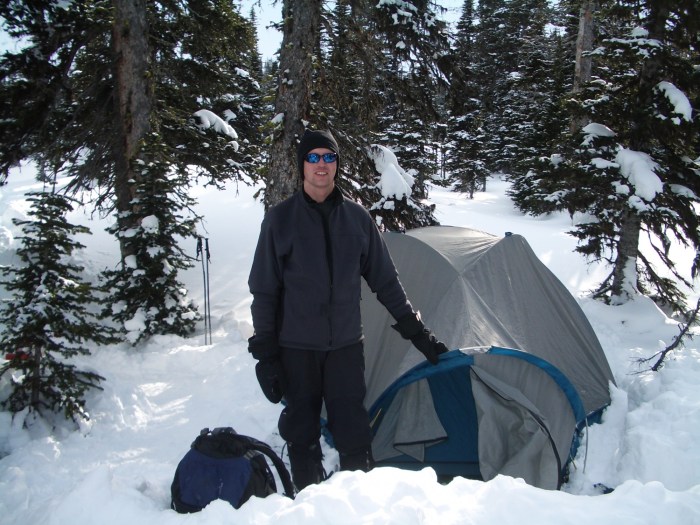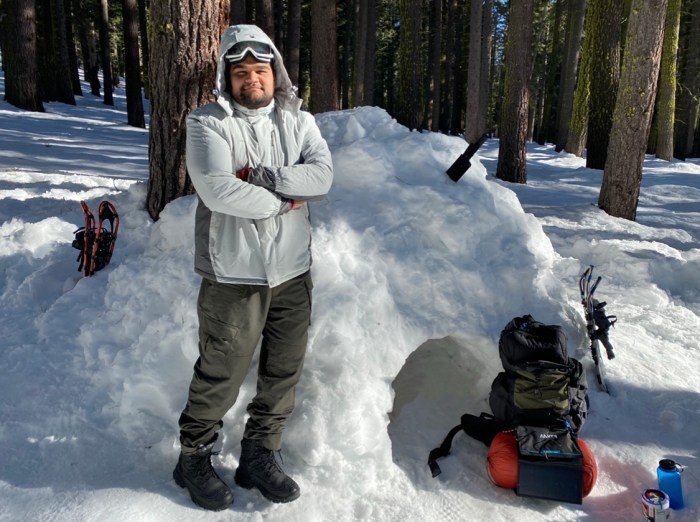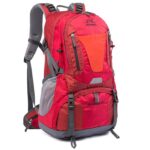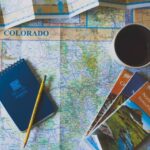Cold Weather Backpacking: Conquering the elements and embracing the breathtaking beauty of winter landscapes requires meticulous planning and the right gear. This isn’t just about surviving the cold; it’s about thriving in it, experiencing the unique magic of a snow-covered wilderness, and pushing your limits in a way that summer backpacking simply can’t match. From mastering layering techniques to navigating treacherous terrain, this guide will equip you with the knowledge and confidence to embark on a safe and unforgettable cold-weather adventure.
We’ll delve into essential gear, crucial planning steps, navigation strategies for snowy conditions, nutritional needs for staying energized in the cold, efficient camp setup techniques, and Leave No Trace principles specific to winter backpacking. This isn’t just a survival manual; it’s your roadmap to an extraordinary experience. Get ready to elevate your backpacking game to a whole new level.
Gear Essentials for Cold Weather Backpacking

Cold weather backpacking presents unique challenges, demanding meticulous gear selection to ensure safety and comfort. Improper preparation can lead to hypothermia and other serious risks, significantly impacting your trip. Prioritizing lightweight yet highly effective gear is paramount to a successful and enjoyable experience. This section details essential gear categories and provides a sample packing list for a 3-day trip.
Essential Gear Categories for Cold Weather Backpacking
Choosing the right gear is crucial for a safe and enjoyable cold-weather backpacking trip. The following table categorizes essential items, offering brand examples and considerations for cold weather conditions.
| Item | Function | Brand Examples | Considerations for Cold Weather |
|---|---|---|---|
| Backpack | Carries all your gear | Osprey, Gregory, Deuter | Choose a pack with a capacity appropriate for your trip length and consider a pack cover for snow and rain protection. |
| Tent | Shelter from the elements | Big Agnes, MSR, REI Co-op | Opt for a four-season tent designed to withstand strong winds and heavy snow. Ensure adequate ventilation to prevent condensation buildup. |
| Sleeping Bag | Provides warmth at night | Western Mountaineering, Feathered Friends, NEMO | Choose a sleeping bag with a temperature rating significantly lower than the expected low temperature. Consider a down bag for warmth-to-weight ratio, or synthetic for moisture resistance. |
| Sleeping Pad | Insulates from the cold ground | Therm-a-Rest, Exped, Sea to Summit | Select a pad with a high R-value (insulation rating) for optimal ground insulation. Consider inflatable pads for comfort and packability. |
| Clothing (Base Layer) | Wicks moisture away from skin | Merino Wool (Icebreaker, Smartwool), Synthetic (Patagonia Capilene) | Merino wool or synthetic materials are best for their moisture-wicking properties. Avoid cotton. |
| Clothing (Mid Layer) | Provides insulation | Fleece (Patagonia R1, Arc’teryx Delta), Down Jacket (Arc’teryx Cerium LT) | Fleece or down jackets offer excellent insulation. Consider a lightweight down jacket for versatility. |
| Clothing (Outer Layer) | Protection from wind and precipitation | Gore-Tex Jacket (Arc’teryx Beta AR, Patagonia Torrentshell), Waterproof Pants (Outdoor Research Helium II) | Waterproof and windproof outer layers are essential for protection from the elements. |
| Hiking Boots | Foot protection and support | Salomon, Hoka One One, La Sportiva | Choose insulated boots with good traction for snowy and icy conditions. Ensure proper fit to avoid blisters. |
| Headlamp/Flashlight | Illumination in low-light conditions | Black Diamond, Petzl | Bring extra batteries. |
| Cooking System | Prepare meals | Jetboil, MSR PocketRocket, Snow Peak | Consider fuel efficiency in cold temperatures. |
| Navigation | Map, compass, GPS | Garmin, Suunto | Learn how to use your map and compass before your trip. |
| First-aid Kit | Treat minor injuries | Various brands available | Include items specifically for cold weather injuries, like blister treatment and hand/foot warmers. |
| Water Bottles/Hydration Reservoir | Carry and store water | Camelbak, Platypus | Insulated bottles can help prevent water from freezing. |
| Trekking Poles | Improved stability and balance | Black Diamond, Leki | Helpful on uneven terrain and snowy conditions. |
| Sunscreen and Sunglasses | Protection from sun and snow glare | Various brands available | Snow reflects sunlight intensely, increasing the risk of sunburn and eye damage. |
Sample 3-Day Cold Weather Backpacking Packing List
This packing list prioritizes weight and warmth for a 3-day trip. Remember to adjust based on specific conditions and personal needs. Always check the weather forecast before you leave.
This list focuses on minimizing weight while maximizing warmth. Remember that individual needs may vary, so adjust accordingly.
Note: Weights are estimates and may vary depending on the specific gear chosen.
| Item | Weight (approx.) |
|---|---|
| Backpack (65L) | 4 lbs |
| Tent (4-season) | 3 lbs |
| Sleeping Bag (0°F rating) | 2 lbs |
| Sleeping Pad (R-value 4+) | 1.5 lbs |
| Clothing (Base, Mid, Outer Layers) | 2 lbs |
| Hiking Boots | 4 lbs |
| Headlamp | 0.5 lbs |
| Cooking System (Stove, Fuel, Pot, Utensils) | 1.5 lbs |
| Food (3 days) | 3 lbs |
| Water (3 days) | 6 lbs (variable) |
| First-aid Kit | 0.5 lbs |
| Navigation (Map, Compass) | 0.5 lbs |
| Trekking Poles | 1 lb |
| Sunscreen, Sunglasses | 0.25 lbs |
| Miscellaneous (Toiletries, Repair Kit) | 0.75 lbs |
| Total (estimated) | 27 lbs |
Layering Clothing Systems for Cold Weather Backpacking
A layering system is crucial for regulating body temperature in varying cold weather conditions. Each layer serves a specific purpose, working together to maximize warmth and comfort while minimizing bulk.
Effective layering involves three primary layers: base, mid, and outer.
The base layer is closest to your skin. Its primary function is to wick moisture away, keeping you dry and preventing hypothermia. Materials like merino wool or synthetic fabrics are ideal choices, as they excel at moisture-wicking. Avoid cotton, which retains moisture and can leave you cold and uncomfortable.
The mid layer provides insulation. Fleece jackets or down jackets are excellent choices for this layer. They trap warm air close to your body, providing significant insulation without adding excessive weight or bulk. The choice between fleece and down depends on your preference for warmth-to-weight ratio versus moisture resistance. Down is warmer for its weight, but loses insulation when wet.
Fleece is less warm but more moisture-resistant.
The outer layer acts as a shell, protecting you from wind, rain, and snow. Waterproof and windproof materials like Gore-Tex are commonly used in outer layers. This layer is designed to keep the elements out while allowing moisture vapor to escape, preventing a buildup of sweat and maintaining comfort.
Cold Weather Backpacking Cooking & Nutrition

Fueling your body in frigid conditions is crucial for maintaining energy levels and preventing hypothermia. Cold weather backpacking demands a strategic approach to nutrition, prioritizing high-calorie, easily prepared meals and snacks that can withstand the cold and provide sustained energy. Careful planning and execution are key to successful cold-weather cooking.
High-Calorie Meal and Snack Selection
Choosing the right fuel is paramount. Your body burns more calories in the cold, so you need to replenish those stores effectively. Opt for calorie-dense foods that are lightweight and non-perishable. Think high-fat options like nuts, seeds, dried fruits, and energy bars. Include carbohydrates for quick energy, such as oatmeal, rice, and pasta.
Protein is essential for muscle repair and satiety; consider dehydrated meats, beans, and lentils. Pre-portioned meals significantly simplify cooking in the cold. For example, a backpacking meal might consist of a high-calorie energy bar for a quick snack, followed by a dehydrated chili with rice and beans for dinner, providing a good balance of macronutrients.
Methods for Melting Snow and Preparing Hot Meals
Melting snow for water and preparing hot meals efficiently are critical in cold weather. Several methods exist, each with its pros and cons. Using a stove is the most reliable method for both melting snow and cooking hot meals. Choose a stove designed for cold weather, as some struggle to ignite or function effectively in freezing temperatures.
Alternatively, you can melt snow in a pot over a heat source, ensuring the snow is thoroughly melted before consumption. For hot meals, consider dehydrated or freeze-dried meals, which are lightweight, require minimal preparation, and only need hot water added. A simple, efficient method for melting snow involves placing snow in a pot and adding a small amount of already boiled water to help the process.
This accelerates the melting process, reducing cooking time and fuel consumption.
Maintaining Hydration in Cold Weather
Dehydration is a significant risk in cold weather, even if you don’t feel thirsty. Cold air is dry, and exertion increases your fluid loss. Carry a sufficient supply of water, and melt snow regularly. Consider using a hydration reservoir to keep your water from freezing, and insulating it with a sleeve or placing it inside your sleeping bag.
Electrolyte tablets or powders can help replace essential salts lost through sweat, further aiding hydration. Drinking warm water can be more palatable and aid in rehydration than cold water, and it also helps warm your body from the inside. Monitoring your urine output is a key indicator of hydration status; pale yellow urine indicates adequate hydration.
Cold Weather Backpacking Photography
Capturing stunning images while backpacking in frigid conditions presents unique challenges, but the rewards—breathtaking landscapes and memorable wildlife encounters—are well worth the effort. Mastering cold weather photography involves understanding how light behaves in winter, adapting your composition techniques to the environment, and safeguarding your gear from the elements. This section details essential strategies for capturing compelling photographs in these demanding conditions.
Light and Composition in Cold Weather
Winter light possesses a distinct character. The lower sun angle casts long shadows, creating dramatic contrasts and opportunities for silhouettes. However, shorter days mean less available light, necessitating faster shutter speeds or higher ISO settings, which can introduce noise. Compositionally, consider emphasizing the stark beauty of winter landscapes—snow-covered peaks, frosted trees, icy rivers. Utilize leading lines, such as winding trails or frozen streams, to guide the viewer’s eye through the image.
Experiment with different perspectives; a low angle can emphasize the scale of a snow-covered mountain, while a high angle can capture the vastness of a frozen lake. Remember to always be mindful of the cold and your own safety while experimenting with angles.
Photographing Landscapes in Cold Weather
Photographing landscapes in cold weather requires careful planning and execution. The challenges include dealing with the limited light, potential for frost and ice on your lens, and the overall cold affecting your equipment and dexterity. For example, capturing a sunrise over a snow-capped mountain range demands pre-planning. You’ll need to arrive at your location well before sunrise to scout the perfect composition and allow time for setting up your equipment without haste.
To avoid frost, use a lens hood and consider investing in a blower brush to remove any snow or ice that might accumulate on your lens. A polarizing filter can help reduce glare from the snow and enhance the color saturation of the sky. Remember to check your battery life frequently; cold temperatures significantly reduce battery performance.
Carrying extra batteries and keeping them warm (in an inner pocket, for instance) is crucial.
Photographing Wildlife in Cold Weather
Wildlife photography in cold weather demands patience, respect for the animals, and a strong understanding of their behavior. Animals often become less active in cold conditions, making it challenging to find and photograph them. To improve your chances, research the species you’re hoping to photograph and their typical winter habits. This might involve learning about their preferred habitats, feeding patterns, and activity times.
Using a longer lens will allow you to maintain a safe distance from the animals, minimizing disturbance and ensuring your safety. Remember to dress warmly and in layers, as you’ll likely be spending extended periods of time stationary in the cold waiting for the perfect shot. Always prioritize the animal’s well-being and avoid approaching them too closely.
A tripod is essential for stability, particularly when using a longer lens and in low-light conditions.
Cold Weather Backpacking Photography Checklist
The importance of a well-prepared checklist for cold weather backpacking photography cannot be overstated. It ensures you have all the necessary equipment, prioritize safety, and consider essential composition tips before you embark on your adventure. Overlooking even a single item can significantly impact your photographic success and your overall safety in the cold.
- Camera Gear: Camera body, lenses (wide-angle and telephoto recommended), extra batteries (kept warm), memory cards, lens cleaning kit (blower brush, microfiber cloth), polarizing filter, tripod.
- Clothing: Warm layers (base layers, insulating mid-layers, waterproof outer layers), waterproof gloves (with removable liners for dexterity), warm hat, scarf or balaclava.
- Safety: First-aid kit, map and compass/GPS, headlamp or flashlight with extra batteries, sunscreen, lip balm with SPF, emergency shelter.
- Composition Tips: Consider the light, utilize leading lines, experiment with different perspectives, be mindful of the background, and practice patience.
Cold weather backpacking isn’t for the faint of heart, but the rewards are immeasurable. The pristine beauty of a winter wonderland, the thrill of conquering challenging conditions, and the profound sense of accomplishment are experiences that will stay with you long after you’ve returned home. By understanding the unique challenges and preparing accordingly, you can unlock a whole new dimension of backpacking adventures.
So pack your bags, embrace the cold, and prepare for an unforgettable journey into the heart of winter.

